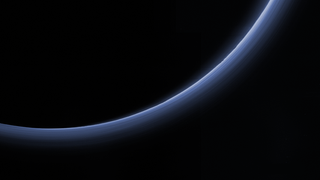Pluto's Blue Bands Get High-Resolution Makeover

Pluto's blue bands shine spectacularly in the highest-resolution image yet of the dwarf planet's atmosphere.
Shown in approximate true color, the band of blue haze is actually a mosaic of four panchromatic images captured by the Long Range Reconnaissance Imager (LORRI), juxtaposed with four-color data from the Ralph/Multispectral Visible Imaging Camera (MVIC), as the New Horizons spacecraft flew by Pluto on July 14. The new high-resolution image was released by NASA's New Horizons team Jan. 14.
The probe captured the pictures as the sun illuminated the scene from the right, NASA officials said in a statement. The image's resolution is 0.6 miles (1 kilometer) per pixel.

The New Horizons team attributes the haze to a photochemical smog created when sunlight hits methane and other molecules in Pluto's atmosphere. A cornucopia of hydrocarbons merges together, creating small particles, less than micrometer (one-millionth of a meter) in size, that diffuse into the bright-blue haze you see in the photo.
Some of the band's horizontal layers actually extend for hundreds of miles around Pluto, and the whole thing rises to altitudes of more than 120 miles (200 km) above Pluto's surface, NASA officials said in the statement.
Follow us @Spacedotcom, Facebook or Google+. Originally published on Space.com.
Get the Space.com Newsletter
Breaking space news, the latest updates on rocket launches, skywatching events and more!
Join our Space Forums to keep talking space on the latest missions, night sky and more! And if you have a news tip, correction or comment, let us know at: community@space.com.
